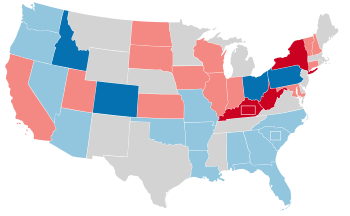| ← 1954 1955 1956 1957 1958 → Presidential election year | |
| Election day | November 6 |
|---|---|
| Incumbent president | Dwight D. Eisenhower (Republican) |
| Next Congress | 85th |
| Presidential election | |
| Partisan control | Republican hold |
| Popular vote margin | Republican +15.4% |
| Electoral vote | |
| Dwight D. Eisenhower (R) | 457 |
| Adlai Stevenson (D) | 73 |
 | |
| 1956 presidential election results. Red denotes states won by Eisenhower, blue denotes states won by Stevenson. Numbers indicate the electoral votes won by each candidate. | |
| Senate elections | |
| Overall control | Democratic hold |
| Seats contested | 35 of 96 seats (32 Class 3 seats + 3 special elections) |
| Net seat change | No change[1] |
 | |
| 1956 Senate results
Democratic gain Democratic hold | |
| House elections | |
| Overall control | Democratic hold |
| Seats contested | All 435 voting members |
| Popular vote margin | Democratic +2.5% |
| Net seat change | Democratic +2 |
 | |
| Gubernatorial elections | |
| Seats contested | 30 |
| Net seat change | Democratic +2 |
 | |
| 1956 gubernatorial election results
Democratic gain Democratic hold | |
The 1956 United States elections were held on Tuesday, November 6, 1956. Incumbent Republican President Dwight D. Eisenhower won reelection in a landslide, while the Democrats retained control of Congress.
In the presidential election, Republican President Dwight D. Eisenhower defeated Democratic former Governor Adlai E. Stevenson of Illinois in a re-match of the 1952 election. Eisenhower won the popular vote by fifteen points and once again won every state outside the South. At the Democratic convention, Stevenson easily defeated New York Governor W. Averell Harriman, taking the nomination on the first ballot.
In the Senate, the party balance of the chamber remained unchanged as Republican and Democratic gains cancelled each other out. In the House, the Democrats picked up two seats, increasing their majority.[2][3][4]
- ^ Democrats picked up two seats in the regularly-scheduled elections, but Republicans picked up two seats in special elections.
- ^ "1956 Presidential Election". The American Presidency Project. Retrieved 9 April 2017.
- ^ "Statistics of the Presidential and Congressional Election of November 6, 1956". U.S. House of Reps, Office of the Clerk. Retrieved 1 March 2021.
- ^ "Statistics of the Presidential and Congressional Election of November 6, 1956 (Revision)" (PDF). U.S. House of Reps, Office of the Clerk. Retrieved 9 April 2017.